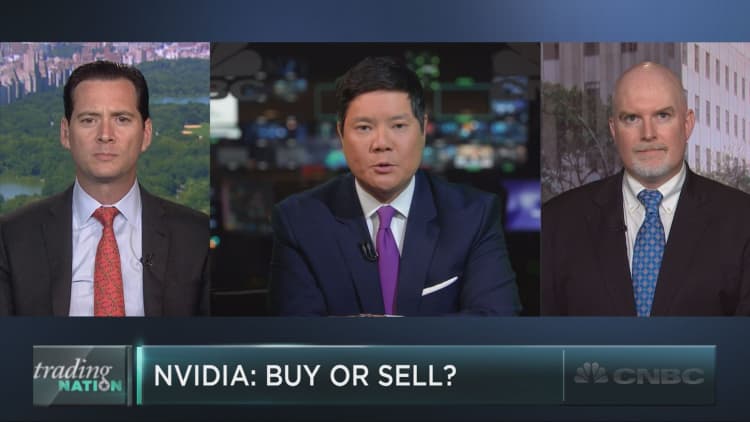
This summer, the semiconductor sector could be the battleground for the bulls and bears.
In a market starved of consistent leadership, the S&P 500 has not made a new high in more than 12 months and is trading just about 2 percent off that record. Some traders hope recent outperformance in chip stocks will prove strong enough to take the broader index to new highs, while uncertainties about growth remain.
"Typically when the market is turning, up or down, it's often led by chip stocks," said John Kosar, chief market strategist at Asbury Research. "The S&P has gone sideways for a year, sideways since April. When that happens we're looking for some kind of leadership. Historically (semiconductors are) an indication for investor appetite for risk."
He noted in a report Tuesday the PHLX Semiconductor Index ETF (SOXX) broke "major overhead resistance" last week. On Thursday, the SOXX closed at its highest since late last June and posted its first nine-day win streak since 2014."
And while the S&P 500 rose just 1.5 percent in May, the chip stock subsector jumped 7.67 percent, to make information technology the top performer for the month.
"To take this market to new highs we need leadership to be growth, and tech, that's certainly growth," said Art Hogan, chief market strategist at Wunderlich Securities.
Meanwhile, bets against chip stocks are rising. Last Thursday, the average stock in the SOXX had a short position of 4.65 percent, the highest since September 2013, according to Markit daily short interest data. In the days since, short interest levels have stayed near that high.
"I think the rising short interest indicates there's increasing concern a near-term rally is unwarranted on a fundamental basis," said John Vinh, senior research analyst, semiconductors, at Pacific Crest Securities. He attributed the recent chip stock rally to recovery from low valuations and better-than-forecast expectations.
Semiconductor stocks in the SOXX posted a 12.7 percent year-over-year decline in earnings per share in the first quarter, and are expected to report a 5.4 percent drop in EPS in the second quarter, according to analysis by Thomson Reuters Eikon's David Aurelio.
Read MoreTrader bets nearly $1M on semiconductor surge
The S&P 500 posted a year-over-year drop of 5.1 percent in earnings per share in the first quarter, and growth is expected to remain negative with a 3.5 percent decline in the second quarter, according to Eikon data.
While the current quarter is likely a bottom in the earnings slump, expectations for growth in the second half may not be enough to push the S&P solidly beyond 2,100 to fresh highs.
"There's a lot of caution out there. Leadership has kind of rotated a lot, which is an indication there isn't a strong theme or direction at this point, consistent with the fact we've bounced in a narrow trend for a year," said Chris Piros, senior vice president, managing director of investment strategy at PNC Asset Management. "The market's fairly topped out and waiting for a catalyst that's not apparent."
Markets also are waiting for resolution of major uncertainties in coming months including the outcome of the U.K. vote on whether to leave the European Union, the timing of the next Fed rate hike, the U.S. presidential election and China's ability to manage an economic slowdown.
Semiconductor performance is closely tied to perceptions of economic growth given their prevalence in a wide range of products from smartphones to microwaves.
"If sentiment were to shift suddenly on the global macro views, that would have an impact on semis," said Angelo Zino, senior equity analyst at S&P Global Market Intelligence. He attributed the recent rally in chip stocks to recovery in shares of Apple and "improving sentiment toward the overall economy."
Semis fell 7.6 percent in January as concerns about spillover from a sharp slowdown in China's economy sent the S&P 500 down 5 percent.
Tech was the worst S&P performer in April and lagged for much of May as shares of Apple fell to their lowest in nearly two years on concerns about slowing demand for the iPhone. The stock recovered with a 6.5 percent jump for May after Taiwan's Economic Daily said the tech giant asked suppliers to make more iPhone 7s than expected.
"I think there is risk you could see another slight correction (in semis) related to Apple and the iPhone 6 until you get the 7," Pacific Crest's Vinh said.
The gains in Apple — the largest stock by market cap — are also tenuous as shares have failed to break above their 200-day moving average, Kosar noted. The company is down more than 2.5 percent over the last five trading days, while chip stocks are up more than 1.5 percent.
"In order to have a new leg up, in order to have a multiquarter bull market you need to have both on the same side of the resistance," he said.
Read More Chip stock surge is good omen for S&P 500, tech
To be sure, high levels of short interest in the outperforming semiconductor sector could also push stocks higher if a short squeeze lays the foundation for a rally. High short interest can induce a short squeeze, in which a jump in price forces a large number of short sellers to buy back borrowed securities before they lose too much on their bet that prices were going to fall. As traders rush to get out of short positions, prices move higher.
"The fact that short interest is so high, that represents purchasing power. Any decent news on the economy going forward would place pressure on those shorts," said Bruce Bittles, chief investment strategist at RW Baird.


